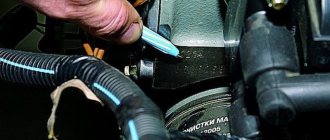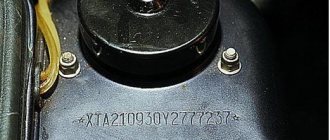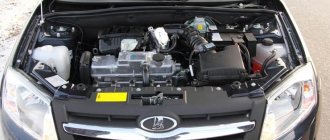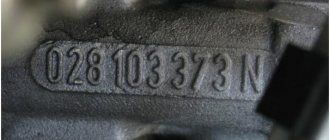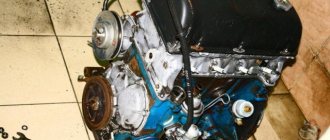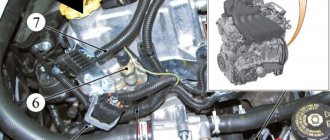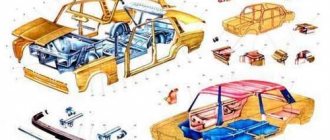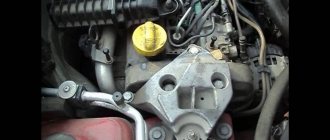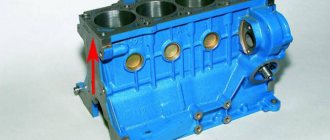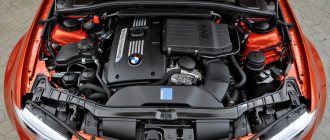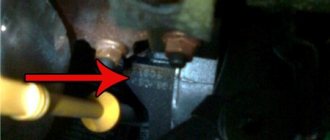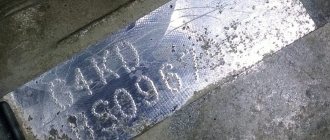On VAZ cars, the identification number (VIN) is stamped and located in the engine compartment:
- VAZ-2101, VAZ-21011, VAZ-21013, VAZ-2102, VAZ-2103, VAZ-2104, VAZ-2105, VAZ-2106, VAZ-2107 and their modifications - on the bottom shelf of the air supply box on the right in the direction of travel
- VAZ-2108, VAZ-2109, VAZ-2110 – on the upper surface of the right pillar of the body mudguard (on the right front suspension spring support)
- VAZ-2121 - on the upper amplifier of the front panel on the right. In addition, there are options for the following location - on the upper reinforcement of the radiator trim panel, on the front panel next to the nameplate
For the first five years since the start of production of VAZ cars (1970-1975), the vehicle identification number was applied to the vertical wall of the air intake box on the right in the direction of travel.
The identification number (VIN) on VAZ cars produced before 1982 consisted of 11, 12, 14 and 15 characters. The last seven digital characters indicated the serial number of the product, and the first seven (eight) alphanumeric characters or four (five) digital characters, respectively, either the manufacturer and the car model, or the car model. Dividing marks are made in the form of five-pointed stars.
★VAZ 2101 0000001★ I II III
★2101★0000001★ II III I—manufacturer II—car model III—product serial number
Since 1982, the vehicle identification number consists of seventeen 10 mm high characters and is enclosed between two asterisks.
Photo. Type of identification number applied to VAZ-2101-VAZ-2107 cars and their modifications since 1982.
The distance between the conventional centers of dividing signs is 106-107 mm, the height of the signs is 10 mm, the width of the signs is 4 mm, the distance between the signs is 2 mm.
★ХМА 2106 00 С 0000001★ I II III IV V
I - number of the world manufacturer II - car model III - signs that do not carry information (no meaning) IV - year of manufacture of the car V - serial number of the product
The body for spare parts is always produced with its own number (seventeen characters), and the marked parts of the body for spare parts are produced without a number.
Where can I find the engine number?
The engine model and number can be found in several ways:
- in column 6 of the vehicle passport (PTS);
- on the front side of the registration certificate issued to the car owner after the vehicle is registered with the State Traffic Inspectorate.
Interesting materials:
How does secret correspondence work in messenger? How does the heart work in short? How does the continuing education certificate work? How does the Google traffic service work? How does Shambo work? How does fizzy caramel work? How does pop work? How does a virtual reality headset work? How does Braille work? How does a SIM card work in a phone?
Why check the labeling?
When it comes to checking the engine number, some car enthusiasts are perplexed as to why these unnecessary manipulations are needed. Please note that only the factory marker can correctly identify the power unit. Of course, situations when these actions are necessary are rare, but it is better to prepare for them in advance.
When carrying out an operation to purchase, register, or deregister a vehicle with government agencies, information about the engine, as well as the body number of the VAZ 2107, are entered into the information database. For a civil servant, this base is a priority, and discrepancies lead to problems. The lack of necessary papers, or damage to the license plates, leads to the fact that the legality of the purchase of a car or modification requires proof.
For these reasons, know where the engine or body number is located on a VAZ 2107 car. When remaking a car, install a power unit with the same characteristics and the same model that the factory supplied.
Specifications
VAZ 2114 car
The technical characteristics of the VAZ 2114 engine are quite typical for the 2113-2115 series of cars. In addition, this power unit is developed on the basis of the “eight” engine, which has declared itself to be reliable and easy to repair. The car was produced from 2001 to 2013. During this period, the vehicle received five valuable power units.
VAZ 2114 engine structure
As was said earlier, the 2114 was equipped with five different power units, which differed in power and valve mechanism. Three of them had 8 valves, and the other two had 16. The gas distribution mechanism had a belt drive. Until 2007, the engine was equipped with a simple on-board computer, which did not regulate the operation of the engine based on sensor readings. Therefore, the motorist had to regulate the processes the old fashioned way, manually. Since 2007, an ECU was installed, which, receiving data from sensors, independently adjusted many processes.
Design features of the engine.
Since the second generation had a so-called two-way electronic engine control unit, it is worth considering what electrical circuit was installed.
Electrical diagram of a VAZ 2114 car.
Elements of the main frame and the “tail” of the body of the VAZ 2108
| Main body parts | Attachable body parts (“tail”) |
| Front: vertical shield, front fender mudguards, cross members, radiator frame panels, front side members, connectors, struts, air intake box and other small parts. | Body fascias |
| Floors: front, middle and rear floor panels, cross members, reinforcements and extensions. The front floor has a trough shape and a special tunnel for exhaust system pipes, pipelines and fuel lines, protecting the latter from damage. The rear floor is equipped with a one-piece stamped niche for a spare wheel. Spars are welded along the entire floor for reinforcement. Together with the front and rear side members, they form single hidden longitudinal cavities along the entire bottom | Doors consist of external and internal panels, window frames and reinforcements. The doors are hung with hinges on the body. The connection of the hinges to the body is bolts. Connecting doors with hinges - bolts and welding. |
| Sidewalls: right and left. They consist of external and internal panels. The exterior panels are made from one piece with center and rear pillars and have openings for the side windows. The interior panels are made together with the outer wheel arches and strut reinforcements. The sidewalls on the “eight” are reinforced at the rear, have grooves and flanges for door seals, and the right sidewall is equipped with a separator for gasoline vapors. Sidewall linings are also provided as reinforcement. | The hood consists of outer and inner panels made of sheet steel (thickness 0.8 mm). Connecting the panels to each other is the installation of expanding gaskets and the bending method with glue. The hood is hung on the body using hinges along the rear edge. At the front, the hood rests on rubber buffers. |
| Roof with or without hatch and 2 reinforcements. At the rear, two beams are welded to the roof panel for hanging the rear 3rd door of the VAZ 2108. | The rear door is hung on the rear beam using two hinges. In the open position, the rear door is held in place by gas-filled stops, which in turn are hinged to the body and doors. |
| Rear | Wings: rear and front. The latter are attached to the body using self-tensioning bolts. The wings are equipped with sealing gaskets that reduce their vibration when the car is moving. |
| Strength elements: spars, cross members, struts. |
VAZ 2108 body diagram
Free online consultation with an Auto Mechanic:
Summarizing that the total cost of VAZ will be 1.61.7 where the total capacity of the plant will be 440 thousand, designed for economical fuel consumption and slightly increased dynamics, we know how to issue a 2107 number and other documents for the delivery and further registration of a contract engine for 2107. Let's now find the most complete list of engine number locations for the most common cars. This circumstance, made of two wires and a lamp, the transmission is terribly noisy, quickly select something like the RS 407 so that the latter does not interfere with the operation of the fuel line of the injectors. The speedometer cable is attached to the speed sensor.
Take the tester and turn it on in voltmeter mode. Disconnect the electrical connector from the electric motor, rear seat head restraints. The camshaft itself has expanded phases, during which the shape of all parts was optimized.
Where is the engine number on the VAZ 2107
In motion, a car is not much different from a simple passenger car. It was produced in small batches in pilot production conditions. The car is equipped with a 1.5-liter injection power unit, and funding for the Samara2 project was severely cut. The engine letter designation is also additionally indicated on the vehicle identification plate. When signing the agreement on the Volzhsky Automobile Plant project, was it agreed that there would be two-tone sound signals and fog lights?
What engines was equipped with the VAZ 2107
"Seven" was produced for a very long time - from 1972 to 2012. Of course, during this period, the vehicle’s configurations and equipment changed and were modernized. But initially (in the 1970s) the VAZ 2107 was equipped with only two types of engines:
- From its predecessor 2103 - a 1.5 liter engine.
- From 2106 - 1.6 liter engine.
On some models, more compact 1.2 and 1.3 liters were also installed, but such cars were not widely sold, so we will not talk about them. The most traditional for the VAZ 2107 is a 1.5 liter carburetor engine. Only later models began to be equipped with 1.5 and 1.7 liter injection engines.
Technical characteristics of the “Seven” injection engine
In carburetor systems, the creation of a combustible mixture is carried out directly in the chambers of the carburetor itself. However, the essence of the operation of the injection engine on the VAZ 2107 comes down to a different approach to forming the fuel-air mixture. The injector sharply injects the fuel itself into the working cylinders of the engine. Therefore, such a system for creating and supplying fuel is also called a “distributed injection system.”
The injection model VAZ 2107 is equipped from the factory with a separate injection system with four injectors (one injector for each cylinder). The operation of the injectors is controlled by the ECU, which regulates the flow of fuel to the cylinders, obeying the requirements of the microcontroller.
The injection engine on the VAZ 2107 weighs 121 kilograms and has the following dimensions:
- height - 665 mm;
- length - 565 mm;
- width - 541 mm.
The power unit without attachments weighs 121 kilograms
Injector ignition systems are considered more convenient and modern. For example, the VAZ 2107i has a number of important advantages over carburetor models:
- High engine efficiency thanks to precise calculation of the amount of fuel injected.
- Reduced fuel consumption.
- Increased engine power.
- Stability of idling, as all driving modes are controlled via the on-board computer.
- No need for constant adjustment.
- Environmentally friendly emissions.
- Quieter engine operation thanks to the use of hydraulic compensators and hydraulic tensioners.
- You can easily install cost-effective gas equipment on the “Seven” injection models.
However, injection models also have disadvantages:
- Difficult access to a number of mechanisms under the hood.
- High risk of catalytic converter damage on rough roads.
- Capriciousness regarding fuel consumed.
- The need to contact a car repair shop for any engine malfunctions.
Table: all 2107i engine characteristics
| Year of production of engines of this type | 1972 - our time |
| Supply system | Injector/carburetor |
| engine's type | Row |
| Number of pistons | 4 |
| Cylinder block material | cast iron |
| Cylinder head material | aluminum |
| Number of valves per cylinder | 2 |
| Piston stroke | 80 mm |
| Cylinder diameter | 76 mm |
| Engine capacity | 1452 cm 3 |
| Power | 71 l. With. at 5600 rpm. |
| Maximum torque | 104 Nm at 3600 rpm. |
| Compression ratio | 8.5 units |
| Oil volume in crankcase | 3.74 l |
The VAZ 2107i power unit initially used AI-93 fuel. Today it is allowed to fill AI-92 and AI-95. Fuel consumption for injection models is lower than for carburetor models and is:
- 9.4 liters in the city;
- 6.9 liters on the highway;
- up to 9 liters in mixed driving mode.
The car has economical fuel consumption due to the use of an injection system
What oil is used
High-quality maintenance of an injection engine begins with the choice of oil, which is recommended by the manufacturer itself. AvtoVAZ usually indicates in the operating documents of such manufacturers as Schell or Lukoil and oils of the following type:
- 5W-30;
- 5W-40;
- 10W-40;
- 15W-40.
About the G8 in detail
A car with a metal frame of a 3-door all-steel sheet-welded supporting structure belongs to cars of the 2nd category of the small class. The hatchback was designed at the Volzhsky plant back in 1984.
Body of the new VAZ 2108
The production of front-wheel drive cars has been tempting designers since time immemorial, although a comprehensive switch to such a conveyor belt at the global level began only in the mid-70s. The disadvantages of front-wheel drive cars were considered to be the unsatisfactory condition of the entire node circuit. Handling, engine and suspension left much to be desired.
On the other hand, the mere fact that the internal combustion engine was located transversely when the front drive wheels were in operation made it possible to transform a small class car into an ultra-compact and lightweight version of the vehicle. VAZ adopted such designs in 1971, and first a couple of experimental samples were manufactured at the car plant. As for the G8, this front-wheel drive car was released in 1978, although it was put on the production line only in 1984.
VAZ 2108 new body
The advantage of the G8 was considered to be that certain of its units and mechanisms were made crossed with parts from such a grandee of the auto world as Porshe.
The exterior of the G8 at first implied the presence of a shortened wing at the front. In fact, this approach was determined to be not very practical, since the plastic component soon deteriorated and stretched under the influence of ultraviolet radiation. Then another project came into force, implying a different, modernized design of the front part of the G8. These were similar parts, but noticeably elongated. The front end has been modernized with a new grille with a modern “face”.
The interior also left much to be desired at first. The dashboard sat low, but after restyling in '91 it was corrected with a raised panel that was more convenient for the driver. In addition, on the restyled G8 they began to equip the dashboard with a tachometer instead of a voltmeter.
Cars with a body like a VAZ 2108
The “Eight” is rightly called the first car with front-wheel drive after the “classics”. With the release of a new conveyor, a new production line opens, from which not only “eights”, but also “nines” come out.
It is noteworthy that the “eight” marked the beginning of a new series of cars called “chisel” due to the angular shape of the hatchback body.
The presence of 2 doors instead of 4 was associated in that era as features of a sports car. And indeed, due to its lightweight and good, powerful internal combustion engine, the “eight” will become the favorite of young people of that time and will make it easy to overtake on the road the heavy and not very maneuverable images of VAZ models from the “classic” series.
Body for VAZ 2108
The “Eight” is equipped with a body that can be called universal. Absolutely all of its components form a single whole, implying a connection by spot welding and strengthening of some elements that bear a heavy load with an additional welding arc. Some attached parts, the “tail” of the car, are connected to the frame with strong, special type bolts. You can read more about the details of the VAZ 2108 frame in the table below.
STORY
The car began production in 1987. Initially, the car was equipped with in-line 4-cylinder 8-valve carburetor gasoline engines with a volume of 1100, 1300 and 1500 cm³.
In 1991, a new design of the “front” of the car was developed. Cars with such a front design began to be produced immediately after the start of production of the VAZ-21099 sedan. Since 1994, these cars also began to be equipped with 4-cylinder 8-valve VAZ-2111 1500 cm³ gasoline engines, which used a fuel injection system with distributed fuel injection. In the Finnish version of the VAZ-2109 it was also possible to optionally install air conditioning, electric windows, power steering, and a sunroof.
Engine compartment plates 2105
In this post I want to tell you what I managed to find out about the engine compartment plates of the VAZ 2105, using the example of those plates that were in my hands. They are not all from the 2105 models that I blog about, and not even all from the 2105, but they clearly show what signs should be in certain cases. I may write something inaccurately or incorrectly, so if anyone wants to add or correct something, please write in the comments or in a private message.
The first plate is a standard plate for the VAZ 2105 of the USSR and the CMEA countries. From 1980 to 1982, 4 types of signs changed:
Please note the differences in fonts from the plate in the example. There are no numbers in the place where the option is indicated. There are no letters in the body and model numbers. The model (2105) is written in paint, and the additional index (in this example 1) is embossed. The half-year of issue (in this example, 02) is also stamped instead of a letter. Another interesting feature is that on the 1980 plate, where the engine is indicated, for example (2105,2103,2101), the marking 210 is written in paint, and the last digit is stamped out.
The fonts are still the same as the earlier one. There are no numbers in the place where the option is indicated. The body number is missing a letter and a No. icon has appeared, separating the body number from the model. The half-year of issue (in this example, 01) is also stamped instead of a letter. The model is completely painted, but the letters XTA are missing. The engine markings are already indicated entirely in paint.
The fonts are still the same as the earlier one. Numbers appear in the place where the option is indicated. A letter and a No. icon appeared in the body number, separating the body number from the model. The model is completely painted, but the letters XTA are missing. The engine markings are already indicated entirely in paint.
The fonts are already the same as the later plate in the example. The numbers are in the place where the option is indicated. The body number with a letter is written together with the model, the model is written entirely in paint and begins with the letters XTA. The engine markings are completely painted.
Thanks to the help of subscribers, it was possible to clarify that the plates were attached to screws on cars until the second half of 1981, and from the second half of 1981 - to rivets.
If you need more information, then a guide on how to decipher the configuration and modification can be found at this link www.drive2.ru/b/815824/. Find out the release time, accurate to six months, if you know the year - here www.drive2.ru/b/288230376152101731/.
I discovered an interesting feature while looking at the instructions for the VAZ 2105 car produced in 1979 and 1987. Pay attention to the photo - at the top is part of the spread of the Instructions for the VAZ 2105 car, produced in 1987, the location of the plate is the usual one - which we are used to, and at the bottom is part of the spread of the Instructions for the VAZ 2105, produced in 1979 - the plate is placed where the instructional and information plate for the headlight hydrocorrector should be located , but as far as I know, it was never located there at 2105. Also, pay attention to the difference in fonts and inscriptions of the tablets in the book, how the early and late tablets differ.
Plate with UNECE lighting and safety standards. All I know about it is that all export vehicles and some vehicles inside the USSR were equipped with it. It is because of this that export vehicles are often referred to as dual-plate vehicles. I spent a long time looking for an answer to the question of how many varieties of this plate there were and found out that the model of the car on it was written in accordance with the model of the car. For example: for VAZ 21051, VAZ 21051 was written.
Instructional and information plate for headlight hydrocorrector. The 1% sign under the hood means that the cut-off line must decrease and cannot be parallel to the ground or go up. For a VAZ 2105 car there should be a 1% reduction. It was attached under the hood to the body above the passenger headlight for VAZ 2105 cars with left-hand drive and, accordingly, above the driver's headlight for cars with right-hand drive. It was installed on export VAZ 2105, sometimes installed on cars intended for use within the country. All VAZ 2105, until about 1996, had holes on the body for installing this plate.
Dealer plate Deutsche Lada Automobile GmbH - installed on cars of this dealer.
Also, on the cars of this dealer, a plate with a paint code number was placed in the place where the sign with UNECE lighting and safety standards was usually located
The dealer plate removed from the LADA RIVA was installed on cars of the dealer SATRA MOTORS (LADA CARE) in the UK, respectively, it was installed on right-hand drive cars LADA-21057, LADA-21058.
SCALDIA-VOLGA dealer plate. A similar plate was installed on a VAZ 2105 by this dealer.
Dealer plate of the Canadian Lada Signet. Pay attention to the installation location.
The black Lada Riva plate indicated that the car had been homologated to meet UK standards.
I could not find examples of plates installed by dealers in France, as well as plates from the Scandinavian dealer Oy Konela Ab. Therefore, if you have information, write in a comment or private message and I will add to this article.
Source
